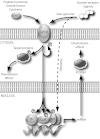Minireview: progress and challenges in proteomics data management, sharing, and integration
- PMID: 22902541
- PMCID: PMC3458223
- DOI: 10.1210/me.2012-1180
Minireview: progress and challenges in proteomics data management, sharing, and integration
Abstract
The proteome represents the identity, expression levels, interacting partners, and posttranslational modifications of proteins expressed within any given cell. Proteomic studies aim to census the quantitative and qualitative factors regulating the biological relationships of proteins acting in concert as functional cellular networks. In the field of endocrinology, proteomics has been of considerable value in determining the function and mechanism of action of endocrine signaling molecules in the cell membrane, cytoplasm, and nucleus and for the discovery of proteins as candidates for clinical biomarkers. The volume of data that can be generated by proteomics methodologies, up to gigabytes of data within a few hours, brings with it its own logistical hurdles and presents significant challenges to realizing the full potential of these datasets. In this minireview, we describe selected current proteomics methodologies and their application in basic and translational endocrinology before focusing on mass spectrometry as a model for current progress and challenges in data analysis, management, sharing, and integration.
Figures


Similar articles
-
The jPOST environment: an integrated proteomics data repository and database.Nucleic Acids Res. 2019 Jan 8;47(D1):D1218-D1224. doi: 10.1093/nar/gky899. Nucleic Acids Res. 2019. PMID: 30295851 Free PMC article.
-
Gel-free mass spectrometry-based high throughput proteomics: tools for studying biological response of proteins and proteomes.Proteomics. 2006 Sep;6(17):4678-87. doi: 10.1002/pmic.200500876. Proteomics. 2006. PMID: 16888762 Review.
-
Proteomic Data Storage and Sharing.Methods Mol Biol. 2017;1549:5-15. doi: 10.1007/978-1-4939-6740-7_2. Methods Mol Biol. 2017. PMID: 27975280
-
Data hoarding is harming proteomics.Nat Biotechnol. 2004 Oct;22(10):1209; discussion 1209. doi: 10.1038/nbt1004-1209a. Nat Biotechnol. 2004. PMID: 15470451 No abstract available.
-
Analytical strategies for the global quantification of intact proteins.Amino Acids. 2012 Sep;43(3):1109-17. doi: 10.1007/s00726-012-1285-z. Epub 2012 Jul 22. Amino Acids. 2012. PMID: 22821264 Review.
Cited by
-
NeuroLINCS Proteomics: Defining human-derived iPSC proteomes and protein signatures of pluripotency.Sci Data. 2023 Jan 11;10(1):24. doi: 10.1038/s41597-022-01687-7. Sci Data. 2023. PMID: 36631473 Free PMC article.
-
The proteomics big challenge for biomarkers and new drug-targets discovery.Int J Mol Sci. 2012 Oct 29;13(11):13926-48. doi: 10.3390/ijms131113926. Int J Mol Sci. 2012. PMID: 23203042 Free PMC article. Review.
-
Review of applications of high-throughput sequencing in personalized medicine: barriers and facilitators of future progress in research and clinical application.Brief Bioinform. 2019 Sep 27;20(5):1795-1811. doi: 10.1093/bib/bby051. Brief Bioinform. 2019. PMID: 30084865 Free PMC article. Review.
-
Advances in the Clinical Application of High-throughput Proteomics.Explor Res Hypothesis Med. 2024 Jul-Sep;9(3):209-220. doi: 10.14218/erhm.2024.00006. Epub 2024 Jul 3. Explor Res Hypothesis Med. 2024. PMID: 39148720 Free PMC article.
-
Guidelines for the design, analysis and interpretation of 'omics' data: focus on human endometrium.Hum Reprod Update. 2014 Jan-Feb;20(1):12-28. doi: 10.1093/humupd/dmt048. Epub 2013 Sep 29. Hum Reprod Update. 2014. PMID: 24082038 Free PMC article.
References
-
- Pardo M, Roca-Rivada A, Seoane LM, Casanueva FF. 2012. Obesidomics: contribution of adipose tissue secretome analysis to obesity research. Endocrine 41:374–383 - PubMed
-
- Cochrane G, Akhtar R, Bonfield J, Bower L, Demiralp F, Faruque N, Gibson R, Hoad G, Hubbard T, Hunter C, Jang M, Juhos S, Leinonen R, Leonard S, Lin Q, Lopez R, Lorenc D, McWilliam H, Mukherjee G, Plaister S, Radhakrishnan R, Robinson S, Sobhany S, Hoopen PT, Vaughan R, Zalunin V, Birney E. 2009. Petabyte-scale innovations at the European Nucleotide Archive. Nucleic Acids Res 37:D19–D25 - PMC - PubMed
-
- Institute of Medicine 2012. Evolution of translational omics: lessons learned and the path forward. Washington, DC: National Academy of Sciences - PubMed
-
- Rhodes DR, Kalyana-Sundaram S, Mahavisno V, Varambally R, Yu J, Briggs BB, Barrette TR, Anstet MJ, Kincead-Beal C, Kulkarni P, Varambally S, Ghosh D, Chinnaiyan AM. 2007. Oncomine 3.0: genes, pathways, and networks in a collection of 18,000 cancer gene expression profiles. Neoplasia 9:166–180 - PMC - PubMed

